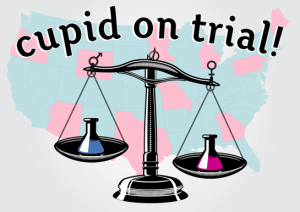Ten fake profiles, one OkCupid experiment: OkCupid On Trial

This week, amateur data analyst Jon Millward published the results of ten fake OkCupid profiles to asess the male-female dynamic in online dating.

Those blog posts no longer happen, and I think a lot of us miss them. We can fill the void a tiny bit with Millward's new, controversial OkCupid experiment.
Jon Millward (known to many for his Analysis of 5000 Call Girl Reviews and Life of a Call Girl: Fantasy vs. Reality) just posted the results of his newest project: OkCupid on Trial: A 4-month Online Dating Experiment Using 10 Fictional Singletons.
Do women really have it easier?
In online dating, especially in discussions about popular dating site OkCupid, it's a widely held belief that attractive young straight women have it easy.
Millward decided to put this to the test by making ten fake profiles to see what kind of results he'd get based purely on superficiality.
Keep in mind that Millward's experiment is hetero-focused, and "attractiveness" can be pretty subjective.
The profile photos Millward used for his experiment were voted on by three separate people who ranked them by who they thought was hot and what was not - or more correctly, what they likely thought other people on OkCupid might consider hot.
The judges were not too far off in guessing the attraction habits in the OkCupid pool used for the wider United States - though I do wonder who the real people are and how they'd feel if they found out about the results...
In the first 24 hours of the profiles being online:
- Each woman received at least one message, but the two best looking women received 581% more messages than the other three combined.
- Only one man received any messages.
In seven days of being live, the profiles delivered a fuller picture of the differences between the experiences of straight women and men on the service:
- The most contacted woman had almost 17 times more messages in a week than the most contacted man.
- Three of the men had no messages, despite their profiles being viewed about 25 times between them.
- The women’s messages outnumbered the men’s 17 to 1 (mostly thanks to the two best looking women).
- The two best looking men received 5 fewer messages than the 3rd and 4th best looking women.
He found that the gender-bias being in women's favor is certainly true in one respect: women do have it "easier" on OkCupid than men when it comes to attracting sheer volumes of attention.
This might not surprise anyone, but seeing just how wide the gulf is between the sexes in a quick and dirty fake profile experiment is pretty eye-opening.
It also gives weight to gender stereotypes many people might find uncomfortable, such as relying on tropes of male agression and female passivity (receptivity) in social sexual situations.
And, it sadly appears here that girls with glasses still get the fuzzy end of the lollipop in mainstream dating.
Men face extreme competition in online dating
The difference in message volume holds up the truism that men encounter extreme competition in the online dating arena.
It's food for thought that while I know men who wish they got the kind of attention that "hot chicks" get on OkCupid, I know just as many more "hot chicks" on the site that find the attention unhelpful in finding someone they'd actually date.
Millward found out that the pretty-girl-gets-attention thing is not brain surgery, but online it's just like in real life - but that kind of attention is, like, on steroids.
However, after digging into it deeper he backed away from the statement that "women have it easier" when it comes to online dating.
Instead Millward concluded that while women may have wider selection capabilities, a number of girls are faced with a signal to noise ratio that can render the selection process into a null.
What's the "perfect" message?
Those of us who have come to expect the moon from Jon Millward's experiments won't be disappointed with the OkCupid experiment.
After his first results, he expanded the project and moved it to England just to see what kind of differences would emerge between the two English-speaking Western countries over time.
He found more of the same: The two most attractive women received 83% of all messages and probably would have gotten more if their inboxes hadn’t maxed out. He added:
It took 2 months, 13 days for the most popular woman’s inbox to fill up. At the current rate it would take the most popular man 2.3 years to fill up his.
After this, Millward started to feel empathy over the womens' bombardment.
So next he wondered, what were all these guys saying to the women - and how could a guy get his message to rise above the inbox noise?
With such heightened message volume to the most attractive (albeit fake) female dating profiles, Millward found himself in the unique position of being able to read all those messages - and see all the different ways that men competed for the attention and response of a single female when given only one chance to do so.
While I'd just as much like to know how women messaged the "attractive" men, seeing what happened in the most extreme area of competition is just as interesting.
After reading several hundred [messages] in the women’s inboxes, most men compliment the attractive women a lot, they make reference to something in the woman’s profile (you would not believe how many times men mentioned the party tricks and ‘Arrow’ the cheetah from the generic profile I wrote), or they ask a general question about travel or something equally boring.
Based on reading hundreds of eager messages, Millward concluded that a successful message should:
- Demonstrate creativity, intelligence and great sense of humour
- Be totally different to anything she may have received before
- Be obviously unique and not a cut-and-paste job
- Show that I’ve read her profile and absorbed facts about her
- Not be needy!
The above suggestions may seem like basic advice, but a few of his conclusions are much trickier to execute than you'd think and show that few men (in the UK at least) show that they've read a girl's profile.
And when all you have to do is pay attention to rise above the fray, it doesn't seem so hard to compete with the masses after all.
This article is the first in a series on Pulp Tech about gaming OkCupid. Stay tuned for the next installment.